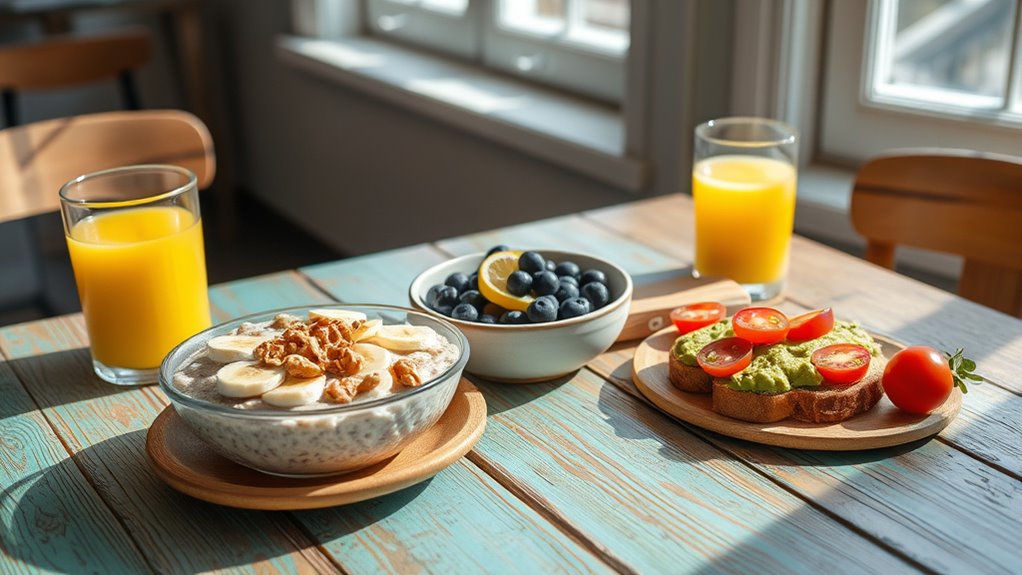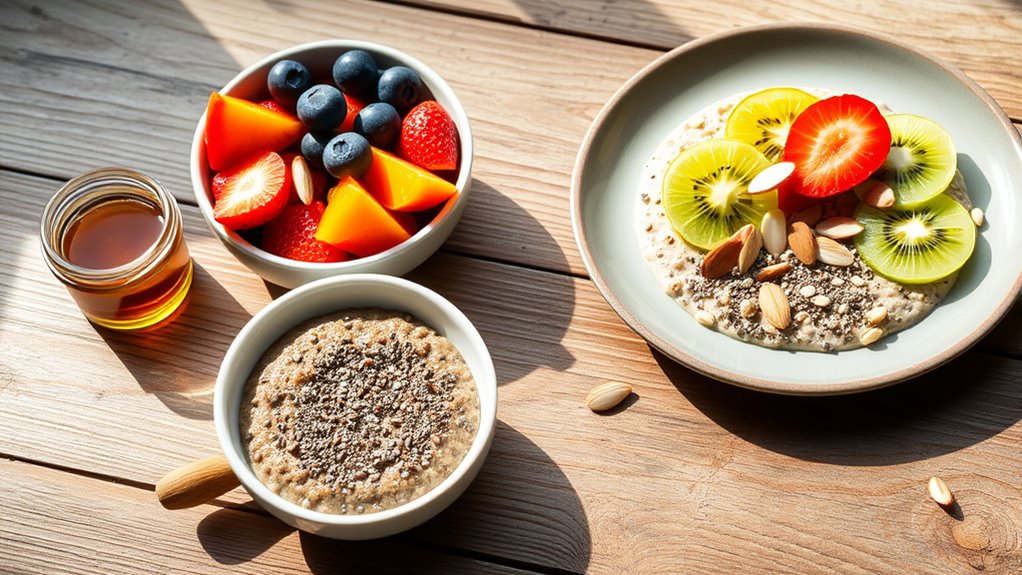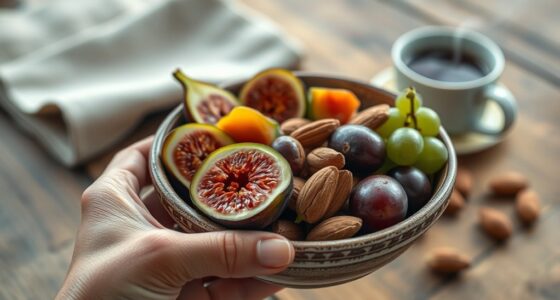To adopt Blue-Zone breakfast habits, focus on nutrient-rich, plant-based meals with Mediterranean grains like oats or farro combined with legumes such as beans or lentils. Opt for minimally processed foods, skip sugary cereals, and include fresh fruits, nuts, and seeds for sustained energy. These choices support your health and longevity by stabilizing blood sugar and boosting fiber intake. Keep exploring for more practical tips to incorporate these wholesome options into your mornings.
Key Takeaways
- Prioritize whole, minimally processed grains like oats, barley, and farro for sustained energy and digestive health.
- Incorporate plant-based proteins such as legumes and chickpeas to promote satiety and nutrient diversity.
- Focus on simple, nutrient-rich meals combining grains and proteins, like oatmeal with fruit or lentil salads.
- Avoid refined grains and sugary cereals to enhance nutrient density and support overall well-being.
- Emphasize variety, moderation, and traditional Mediterranean ingredients to align with Blue-Zone longevity habits.

Many of the world’s longest-lived communities start their day with simple, nutrient-rich breakfasts that prioritize whole foods and balance. These meals often feature Mediterranean grains like oats, barley, and farro, which provide complex carbohydrates and fiber to keep you energized and satisfied. Incorporating these grains into your breakfast can help stabilize blood sugar levels and promote digestive health. You might enjoy a warm bowl of oatmeal topped with fresh fruit, nuts, and a drizzle of honey, or a hearty farro porridge mixed with seeds and berries. The key is choosing minimally processed grains that retain their natural nutrients, supporting both longevity and overall well-being. Emphasizing whole foods in your diet aligns with traditional Blue-Zone eating habits and enhances nutrient absorption.
Start your day with whole grains like oats and farro for lasting energy and wellness.
Plant-based proteins also play a fundamental role in these traditional diets. Legumes such as beans, lentils, and chickpeas are common breakfast staples in Blue-Zone communities. These proteins are rich in fiber, vitamins, and minerals, and they help you feel full longer. You could add hummus to whole-grain toast or include a side of lentil salad with your morning meal. The focus is on combining plant proteins with grains to create balanced, nutrient-dense breakfasts that fuel your day without relying on processed foods or animal products. This approach not only supports heart health but also reduces inflammation and promotes longevity.
When you adopt these principles, you’re choosing foods that are naturally satisfying and nourishing. Many Blue-Zone diets emphasize moderation and variety, so mixing Mediterranean grains with plant-based proteins can help you discover new flavors and textures while staying aligned with proven health benefits. For example, a breakfast burrito made with whole-grain tortillas, filled with black beans, sautéed vegetables, and avocado, captures this balance perfectly. These meals are straightforward to prepare, portable, and adaptable to your preferences, making it easier to stick with healthy habits over the long term.
It’s important to remember that the foundation of these breakfasts is whole, minimally processed foods. Skip refined grains and sugary cereals, and instead focus on the rich flavors and nutrients that come from authentic ingredients. Incorporating Mediterranean grains and plant-based proteins into your morning routine can considerably impact your health — helping you maintain energy, support heart health, and potentially extend your lifespan. By making these simple yet intentional choices, you’re not only honoring the traditions of Blue-Zone communities but also taking proactive steps toward a longer, healthier life.
Frequently Asked Questions
How Do Blue-Zone Breakfasts Differ From Typical Western Breakfasts?
You notice that Blue-Zone breakfasts focus more on Mediterranean grains and plant-based proteins, unlike typical Western breakfasts that often rely on processed foods and meats. You’ll find wholesome, nutrient-dense options like whole grains, beans, and fruits, which support longevity. By choosing these meals, you embrace a diet that’s heart-healthy and sustainable, helping you feel energized and satisfied throughout the day.
Can Blue-Zone Eating Habits Be Adapted for Modern Urban Lifestyles?
You can adapt blue-zone eating habits for urban nutrition by incorporating simple, wholesome foods into your busy lifestyle. Focus on nutrient-dense options like fruits, nuts, and whole grains that are easy to prepare and carry. Prioritize lifestyle integration by planning meals ahead, eating slowly, and making time for nutritious breakfasts. This approach helps you maintain healthy habits amidst urban chaos, boosting your well-being every day.
What Are Common Obstacles to Adopting Blue-Zone Breakfast Routines?
Imagine waking up busy and skipping a nourishing breakfast. Common obstacles you face include cultural differences, which might prioritize quick, traditional meals over Blue-Zone routines, and accessibility issues, like limited healthy options nearby. These challenges make it hard to adopt consistent, wholesome breakfast habits. Overcoming them requires understanding your cultural context and finding accessible, simple ways to include nutritious foods that fit into your morning routine.
Are Blue-Zone Breakfast Foods Suitable for Children and Teenagers?
You might wonder if Blue-Zone breakfast foods suit children and teens. They generally do, as these foods emphasize whole grains, fruits, and healthy fats, which support children’s nutrition and teen dietary habits. However, you should adapt portions and ingredients to meet their specific needs. Incorporate familiar, tasty options to encourage healthy eating habits, making sure the meals are balanced, nutritious, and appealing for their age groups.
How Do Seasonal Changes Affect Blue-Zone Breakfast Choices?
Imagine the changing hues of dawn, as seasonal produce and cultural influences gently sway your breakfast choices. As seasons shift, you might find yourself embracing fresh berries in summer or warm, hearty grains in winter. These natural variations inspire you to adapt blue-zone breakfast options, honoring local harvests and traditions. By doing so, you keep your mornings nourishing and vibrant, seamlessly blending nature’s rhythm with your nutritional well-being.
Conclusion
As you embrace blue-zone breakfasts, remember you’re joining the ranks of those who enjoy long, vibrant lives—like the legendary centenarians of Okinawa or Sardinia. Just as a sunrise signals a new day, a wholesome morning meal sets the tone for vitality and longevity. So, choose nourishing foods with purpose, and let each breakfast be your daily toast to health, echoing the timeless wisdom of those who’ve mastered the art of living well.









